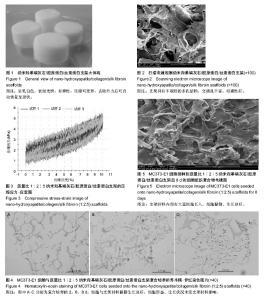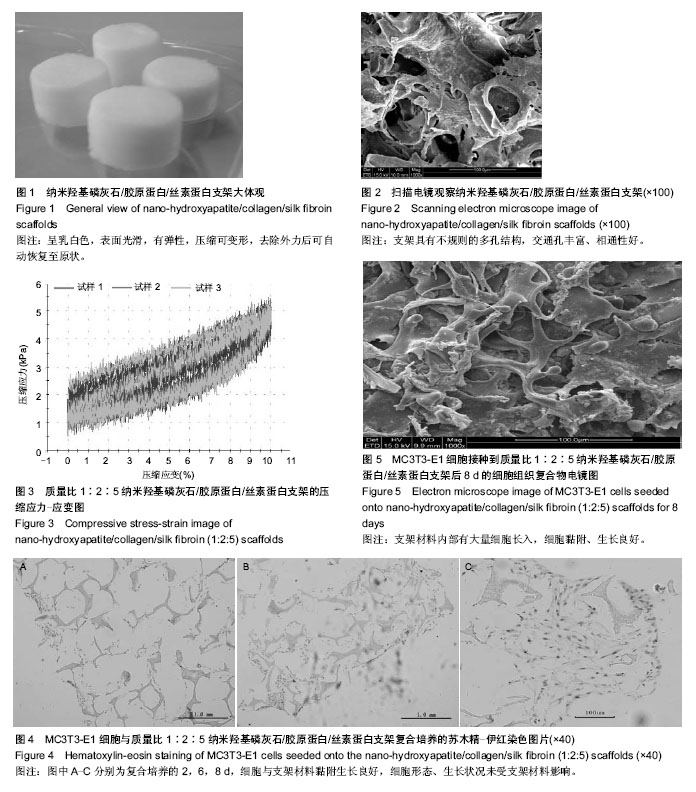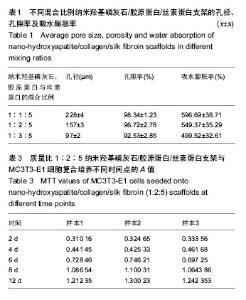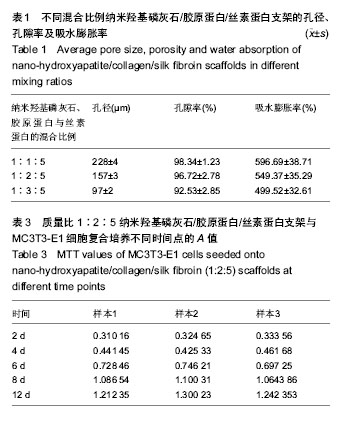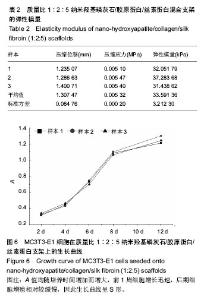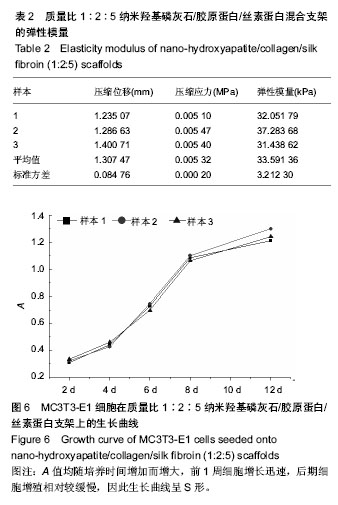| [1] 马亮,王洪,李艳军,等.三维丝素支架制备及其与骨髓间充质干细胞的生物相容性[J].中国组织工程研究与临床康复,2007,11(40): 8021-8024.
[2] 施李杨,明英.丝素蛋白生物材料在骨科修复中的应用研究进展[J].蚕业科学,2013,39(4):812-819.
[3] 唐鸣,赵霞,陈新,等.多孔丝素蛋白支架修复兔下颌骨临界性骨缺损[J].中国组织工程研究, 2013, 17(8):1337-1343.
[4] 徐宁,陈玉云,钟建,等.丝素蛋白对纳米羟基磷灰石晶体生长的调控作用[J].中国组织工程研究,2013,17(3):427-432.
[5] Guo CA,Liu XG,Huo JZ,et al.Novel gene-modified-tissue engineering of cartilage using stable transforming growth factor-β1-transfected mesenchymal stem cells grown on chitosan scaffolds.J Biosci Bioeng.2007;103(6):547-556.
[6] Wei G,Ma PX.Structure and properties of nano-hydroxyapatite/polymer composite scaffolds for bone tissue engineering.Biomaterials.2004;25(19):4749-4757.
[7] 李瑞琦,张国平,任立中,等.纳米羟基磷灰石及其复合生物材料的特征及应用[J].中国组织工程研究与临床康复,2008, 12(19): 3747-3750.
[8] Yang CR,Wang YJ,Chen XF.Preparation and evaluation of biomimetric nano-hydroxyapatite-based composite scaffolds for bone-tissue engineering. Chinese Sci Bull.2012;57(21): 2787-2792.
[9] 王江,左奕,杨维虎,等.纳米羟基磷灰石-丝素蛋白仿生矿化材料的制备研究[J].无机材料学报,2009,2(24):264-268.
[10] 刘琳,孔祥东,蔡玉荣,等.纳米羟基磷灰石/丝素蛋白复合支架材料的降解特性及生物相容性研究[J].化学学报,2008,66(16): 1919-1923.
[11] Ghaznavi AM,Kokai LE,Lovett ML,et al.Silk fibroin conduits: acellular and functional assessment of peripheral nerve repair.J Ann Plast Surg.2011;66(3):273-279.
[12] 王宏昕,李敏.丝素蛋白作为组织工程生物材料的研究进展[J].中国修复重建外科杂志,2008,2(22):192-195.
[13] 邢帅,夏亚一,袁凌伟,等.聚乳酸/丝素蛋白复合组织工程支架的制备及生物学性能的评价[J].吉林大学学报:医学版,2008,34(3): 40-410.
[14] Mauney JR,Cannon GM,Lovett ML,et al.Evaluation of gel spun silk-based biomaterials in a murine model of bladder augmentation. J Biomaterials.2011;32(3):808-818.
[15] 谢敏凯,徐月敏.丝素蛋白材料在组织工程中的新进展[J].中国组织工程研究,2012, 16(43):8105-8110.
[16] 孔令玲,李延报.丝素蛋白支架的制备及其在组织工程中的应用[J].材料科学与工程学报,2013,31(4):614-620.
[17] Meinel L,Hofmann S,Karageorgiou V,et al.The inflammatory responses to silk films in vitro and in vivo.Biomaterials.2005; 26(2):147-155.
[18] Tripathi G, Basu B.A porous hydroxyapatite scaffold for bone tissue engineering: Physico-mechanical and biological evaluations.Ceram Int.2012;38(1):341-349.
[19] 宁志刚,杨柳.胶原蛋白水凝胶在软组织工程中的应用[J].中国骨伤,2011,10(24):884-886.
[20] W?odarski KH,W?odarski PK,Galus R.Bioactive composites for bone regeneration Review.Ortop Traumatol Rehabil.2008; 10(3): 201-210.
[21] Kretlow JD, Mikos AG.Review: mineralization of synthetic polymer scaffolds for bone tissue engineering.Tissue Eng. 2007;13(5):927-938.
[22] Nair MB,Kretlow JD,Mikos AG,et al.Infection and tissue engineering in segmental bone defects—a mini review.Curr Opin Biotechnol.2011;22(5):721-725.
[23] 武继民,今村保忠,水野一乘,等.Ⅰ型和Ⅴ型胶原的提取精制及其结构分析[J].军事医学科学院院刊,2003,27(4):280-282.
[24] Szpalski C,Wetterau M,Barr J,et al.Bone tissue engineering: Current strategies and techniques—Part I: Scaffolds.Tissue Eng Part B Rev.2012;18(4):246-257.
[25] 李东亚,郑欣,陈一心.骨组织工程支架材料应用于大段骨缺损的实验研究进展[J].创伤外科杂志,2013,15(1):87-90.
[26] Lacroix D,Chateau A,Ginebra MP,et al.Micro-finite element models of bone tissue-engineering scaffolds.Biomaterials. 2006;27(30):5326-5334.
[27] Hollister SJ.Porous scaffold design for tissue engineering. Nat Mater.2005;4(7):518-524.
[28] Burg KJ,Porter S,Kellam JF.Biomaterial developments for bone tissue engineering.Biomaterials. 2000;21(23): 2347- 2359.
[29] Sanzana ES,Navarro M,Ginebra MP,et al.Role of porosity and pore architecture in the in vivo bone regeneration capacity of biodegradable glass scaffolds.J Biomed Mater Res A.2014; 102(6):1767-73.
[30] Murphy CM,Haugh MG,O'Brien FJ.The effect of mean pore size on cell attachment, proliferation and migration in collagen–glycosaminoglycan scaffolds for bone tissue engineering.Biomaterials.2010;31(3):461-466.
[31] 刘毅,肖宏涛,薛美思.适宜于构建组织工程化脂肪的蚕丝蛋白支架:最佳孔径筛选[J].中国组织工程研究,2010,14(8): 1361- 1364.
[32] Currey JD.The mechanical properties of bone.Clin Orthop Relat Res.1970;73: 210-231.
[33] Gerlier D,Thomasset N. Use of MTT colorimetric assay to measure cell activation. J Immunol Methods.1986;94(1-2): 57-63.
[34] 张燕搏,姜明,王强,等.组织工程血管材料体外细胞毒性评价实验研究[J].中华实用诊断与治疗杂志,2011,25(6):539-542.
[35] 国家食品药品监督管理局济南医疗器械质量监督检验中心.GB/T 16886.5-2003/ISO 10993-5:1999.医疗器械生物学评价.第5部分:体外细胞毒性试验[S].北京:中国标准出版社, 2003. |
